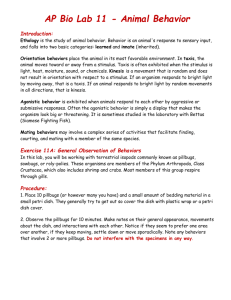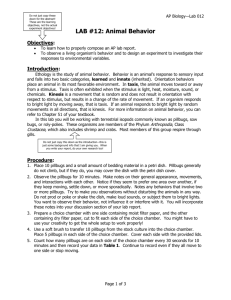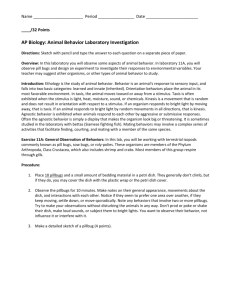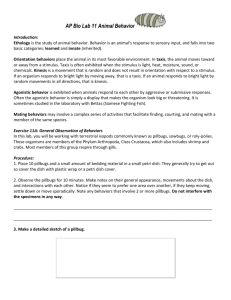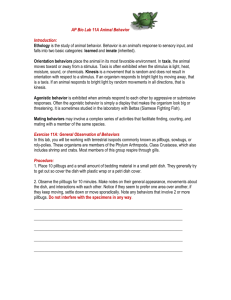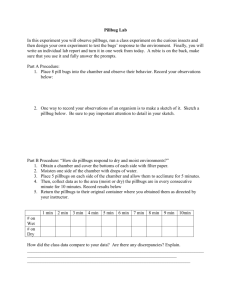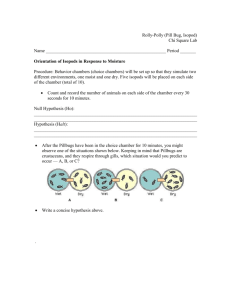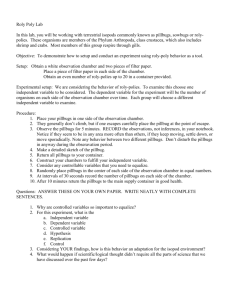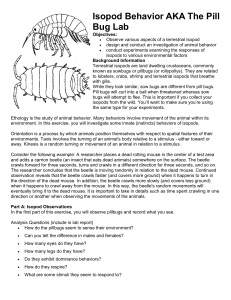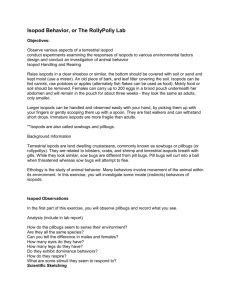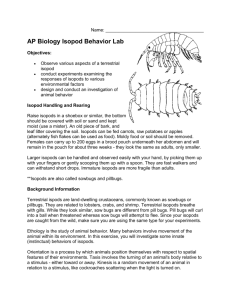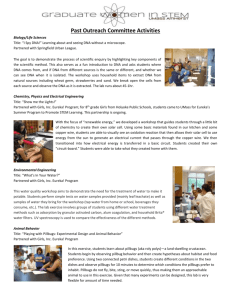AP Bio Lab 11 - ViewpointAPBiology
advertisement
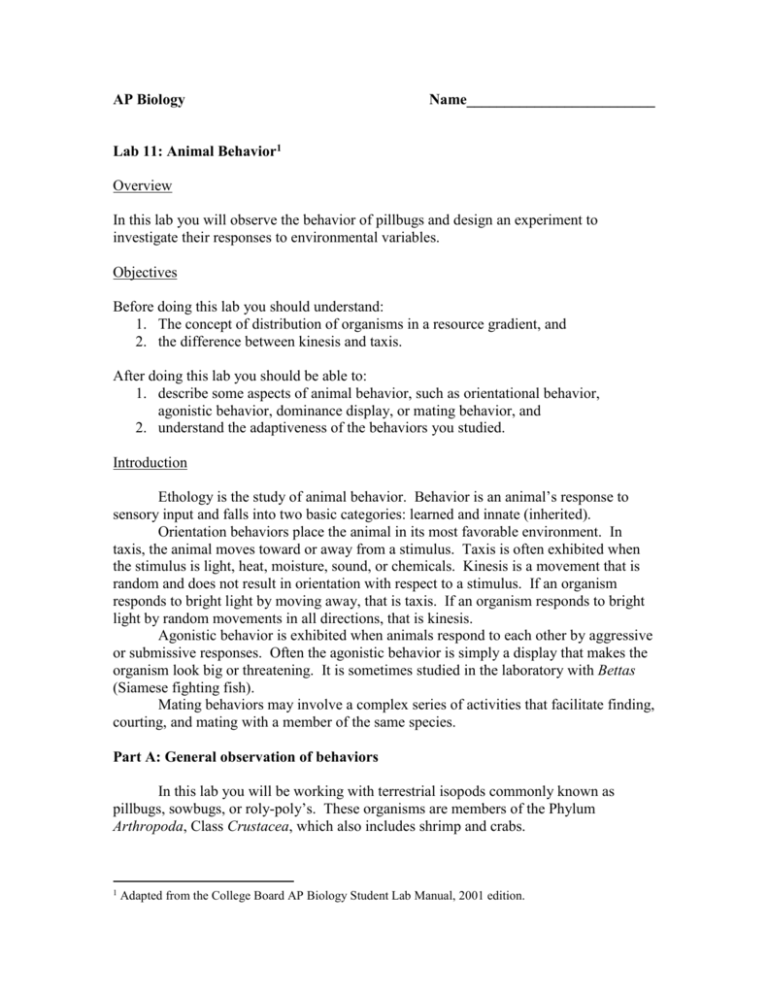
AP Biology Name_________________________ Lab 11: Animal Behavior1 Overview In this lab you will observe the behavior of pillbugs and design an experiment to investigate their responses to environmental variables. Objectives Before doing this lab you should understand: 1. The concept of distribution of organisms in a resource gradient, and 2. the difference between kinesis and taxis. After doing this lab you should be able to: 1. describe some aspects of animal behavior, such as orientational behavior, agonistic behavior, dominance display, or mating behavior, and 2. understand the adaptiveness of the behaviors you studied. Introduction Ethology is the study of animal behavior. Behavior is an animal’s response to sensory input and falls into two basic categories: learned and innate (inherited). Orientation behaviors place the animal in its most favorable environment. In taxis, the animal moves toward or away from a stimulus. Taxis is often exhibited when the stimulus is light, heat, moisture, sound, or chemicals. Kinesis is a movement that is random and does not result in orientation with respect to a stimulus. If an organism responds to bright light by moving away, that is taxis. If an organism responds to bright light by random movements in all directions, that is kinesis. Agonistic behavior is exhibited when animals respond to each other by aggressive or submissive responses. Often the agonistic behavior is simply a display that makes the organism look big or threatening. It is sometimes studied in the laboratory with Bettas (Siamese fighting fish). Mating behaviors may involve a complex series of activities that facilitate finding, courting, and mating with a member of the same species. Part A: General observation of behaviors In this lab you will be working with terrestrial isopods commonly known as pillbugs, sowbugs, or roly-poly’s. These organisms are members of the Phylum Arthropoda, Class Crustacea, which also includes shrimp and crabs. 1 Adapted from the College Board AP Biology Student Lab Manual, 2001 edition. Before coming to lab 1. Read through the procedure below so you know what you will be doing. You do not need to copy the procedure. 2. Leave space in your lab notebook for your notes and drawing(s). One page is sufficient. Procedure 1. Place 10 pillbugs and a small amount of bedding (cotton or part of a paper towel) in a Petri dish. Pillbugs generally do not climb, but if they do, you may cover the dish to keep them inside. 2. Observe the pillbugs for 10 minutes. In your lab notebook, make extensive notes on their appearance, movements about the dish, and interactions with each other. Notice if they seem to prefer one area over another, if they keep moving, settle down, or move sporadically. Note any behavior that involves more than one pillbug. Try to make your observations without disturbing the pillbugs in any way. Do not prod, poke, or shake the dish, make loud sounds, or subject them to bright lights. Your job is to observe their behavior, not influence it. Use the full 10 minutes to notice as much as you can. 3. Make a detailed sketch of a pillbug. Your sketch should have a title and should have notes as appropriate. Part B: Kinesis in Pillbugs Before coming to lab 1. Read the procedure below. Write out the procedure in your lab notebook using your own words or drawings. 2. Write a hypothesis that makes a prediction about the pillbugs’ behavior in this experiment. Use correct format. 3. Set up a data table that allows you to record numbers and comments every 0.5 minute for 10 minutes. Include a zero time point. Give your table a title. 4. Leave a page blank for your graph and conclusion. Procedure 1. Obtain a choice chamber with two connected chambers. Line one chamber with a moist piece of filter paper and the other with a dry piece of filter paper. The filter paper should lie flat so that pillbugs will not crawl underneath it. 2. Use a soft brush to transfer 5 pillbugs from the stock culture into the moist side of the choice chamber and 5 into the dry side. 3. Cover the choice chamber with Plexiglas and count how many pillbugs are in each side of the choice chamber every 30 seconds for 10 minutes. Continue to record even if they stop moving. 4. Also make note of any significant behaviors. 5. Return the pillbugs to the stock culture. Data Analysis 1. Graph the numbers of pillbugs in each chamber at each time point in your lab notebook. Be sure to use proper graph format and label it as Part B. 2. Write a conclusion that states what your hypothesis was and whether it was supported or not. Label this as your Part B conclusion. Questions Answer the following in your lab notebook. Label them as Part B. 1. What conclusions can you draw from your data? 2. What possible physiological reasons might explain the behavior you observed? 3. How do isopods locate an appropriate environment? Base your answers on your observations and any research you deem appropriate. 4. If you suddenly turned a rock over and found isopods under it, what would you expect them to be doing? If you watched the isopods for a few minutes, how would you expect their behavior to change? 5. Is the isopods’ response to moisture best classified as kinesis or taxis? Explain your response. Part C: Student-Designed Experiment In this section of the lab, you will be performing an experiment similar to the one you performed in Part B, but you will test a different variable and design the experiment with your partner(s). You may test the effect of pH, solutes, light, color, surface texture, or temperature. The following materials will be available: filter paper, water, vinegar, mild base, ice, thick paper to block light, sandpaper, salt water, and colored plastic wrap. Before coming to lab 1. Meet with your partner(s) and decide what variable you want to test and how you will control other possible variables. 2. Write your objective for the experiment in your lab notebook. Be specific. 3. Write a hypothesis in your lab notebook. Use proper format. 4. Write a list of all the materials you will need in your lab notebook. 5. Write out your procedure in detail in your lab notebook. You can use numbered steps, pictures, or paragraph form. 6. Set up a data table for the data you will collect during lab. Ten minutes of data collection is adequate. Remember to include a zero time point and a title for the data table. Procedure 1. During lab time, and after you have completed Part B, perform your experiment. 2. Return your isopods to the stock culture. Data Analysis 1. Make an appropriate graphical representation of your data. Use proper format. 2. Write a conclusion that re-states your hypothesis and tells whether it was supported or not. Label it as your Part C conclusion.
